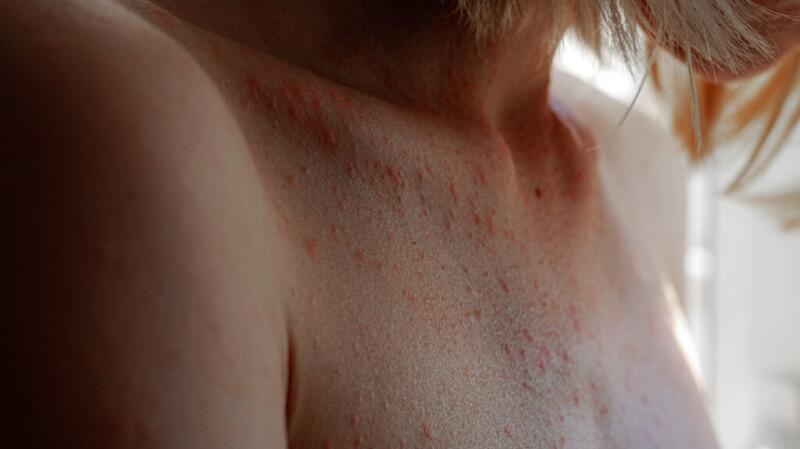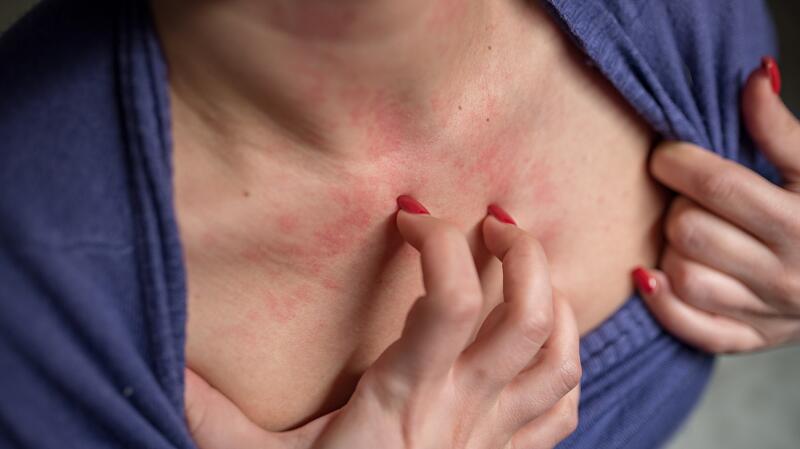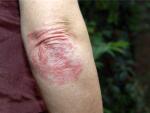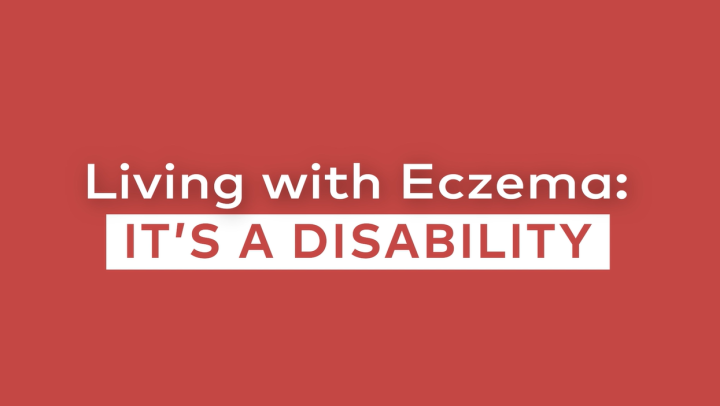This article looks at the causes of stress rashes, related symptoms, what stress rashes look like, and some possible ways to treat them. It also looks at diagnosing stress rashes and when you should contact your doctor about it.
What is a stress rash?

A stress rash is a type of hives, which is a rash on your skin that is often itchy. Hives can take several shapes and appear anywhere on your body.
Hives can result from a number of triggers, including:
- stress
- certain foods
- contact with certain chemicals, such as latex
- medication use
- insect bites
You may get hives as a result of stress. However, because it can occur as a result of other factors, it is important to contact your doctor if you are unsure of the cause.
Learn more about the connection between stress and hives.
What does a stress rash look like?
Stress rashes can vary in shape and size, from small bumps to large welts. They can be red, pink, white, or even the same color as your skin.
Can stress cause hives?
Typically, stress itself does not cause hives. However, stress can make existing symptoms worse.
Stress can cause your body to increase its levels of cortisol, and this hormone can cause inflammation to increase. This makes it more likely for hives to appear.
What are the symptoms of a stress rash?
Stress rashes are usually itchy, and they can also present with a stinging or burning sensation. The rash itself can vary significantly in size and appearance, and it can be present for anywhere from a few minutes to a few days.
Learn more about how stress can affect your skin, hair, and nails.
Symptoms of a serious allergic reaction
If you experience stress and have a flare-up of hives, the stress may exacerbate it. However, hives can also occur as a result of a serious allergic reaction, or anaphylaxis.
Seek immediate medical attention if you have hives and any of the following symptoms:
- difficulty swallowing
- lightheadedness
- faintness
- a fast heartbeat
If you have a known allergy and a prescription for an EpiPen or another epinephrine auto-injector, administer this and then seek immediate medical help.
How do I treat a stress rash?
Stress hives typically settles down soon after it appears, usually between a few minutes and a few days. However, during that time, there are some things that you can do to provide yourself with some relief from hives. This includes the following.
- Try to prevent yourself from getting too hot.
- Wear loose-fitting cotton clothes.
- Apply a cold compress to the area several times per day.
- However, do not apply a cold compress if the cold triggers your hives.
- Take over-the-counter anti-itching medications, such as antihistamines.
- Moisturize the area several times per day to help prevent the skin from drying out.
Because stress contributes to hives, it also helps to take steps to reduce your stress levels. These steps can include:
- exercising
- meditating
- practicing mindfulness
Contact your doctor if you wish to discuss ways of managing stress.
What causes a stress rash?
Hives can result from a number of triggers. However, stress itself may not be the main cause. Instead, stress makes breakouts more likely by increasing your body’s production of cortisol. Cortisol is the hormone responsible for inflammation, and an increase in this hormone makes inflammation such as hives more likely.
The main triggers of hives are:
- allergic reactions, including those to:
- foods
- bug bites
- medications
- materials such as latex
- plants
- pollen
- your body’s reaction to sweat, heat, or cold
- exposure to sunlight
- pressure on the skin from clothing
- scratching at your skin
Each of these, combined with stress, can cause a stress rash flare-up.
In addition, hives can also occur as a result of infections and certain treatments. These include:
- strep throat
- urinary tract infections
- COVID-19
- blood transfusions
- radiation therapy
In some cases, medical professionals are unable to determine the cause of hives. However, even if the cause is not known, it is still possible to treat hives.
If you have hives for 6 weeks or longer, and if the cause is unknown, this is called chronic spontaneous urticaria.
Learn about other possible causes of hives.
When should I contact a doctor?
Stress hives can go away within a few days. However, contact your doctor if any of the following apply.
- Symptoms do not improve after 2 days.
- The rash begins to spread.
- Hives keeps recurring.
- You have a high temperature.
- There is swelling under your skin.
Your doctor will be able to run tests to diagnose the cause of the rash, and they may also refer you to a dermatologist.
How do doctors diagnose a stress rash?
When diagnosing your stress rash, your doctor or dermatologist will ask you questions such as:
- How often do you get hives?
- How long have you had the rash?
- What does the rash feel like?
- Do you have any other symptoms?
They can also arrange for tests to help determine the cause of the rash. These can include:
- skin allergy tests to see if you have experienced an allergic reaction
- blood tests to rule out infections or illnesses
- a skin biopsy, in which a sample of the affected skin is sent for laboratory analysis
Can I prevent stress rashes?
If stress contributes to your rash or hives, managing your stress levels can help prevent another breakout.
People manage stress in different ways, but some examples of ways you can reduce stress include:
- practicing yoga
- trying meditation
- doing tai chi
- going for a walk
- spending time with friends or family
- relaxing by listening to music or reading a book
Learn more about the causes of stress and how to reduce your stress levels.
If your stress rashes primarily occur as a result of an allergic reaction or form of irritation, avoiding triggers will help reduce flare-ups.
Summary
A stress rash is a form of hives that occurs when excess stress makes your body release more of the hormone cortisol. Cortisol controls inflammation and makes hives more likely to occur.
Hives can also occur due to an allergic reaction, exposure to hot or cold temperatures, or pressure or scratching on the skin. Typically, hives lasts anywhere from a few minutes to a few days. To soothe your symptoms, you can apply a cold compress or take over-the-counter antihistamines.
However, if hives or a stress rash persists for longer than 2 days or begins to spread, it is best to contact your doctor for advice.























